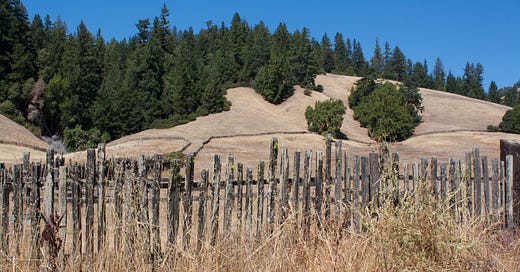There was a rural renaissance in 1970s America. It’s a phenomenon called a turnaround migration, when urban to rural migration increases. The normal trend here for in-country migration has always been from farm to city. But for the first time in our history, Americans were migrating to rural areas at a higher rate than to urban areas. Who were those migrants? Hippie communes were short-lived, but the back-to-the-landers had staying power because they became land owners. My family included.
My newly divorced mom packed me, my three sisters, and our dog into our GMC van and we headed north, out of Topanga Canyon to the redwoods on the coast of Northern California. Answering the call to return to the garden, she bought a five acre farm in Comptche, a town with a post office, tiny store, Grange hall, and a K-4 grade school. A commune had recently been established on an old-time ranch near the Montgomery Woods, inherited by a son who was part of the Movement.
The micro town in the redwoods had lost half its population, previously around 500, after a series of mill fires in the previous decade. Well-established homesteads were for sale for cheap, relatively speaking. Back-to-the-landers increased the town’s population by one-third during the early 1970s, burgeoning to around 350 in just a few years.
At the outset, the relationship was rocky between established rural residents and urban newcomer immigrants. How this particular community resolved their conflict by the end of the decade is the central question of this ethnography:
How did back-to-the-landers and old-time ranchers and loggers resolve their conflict based on fear of the other?
To answer my question, I had to find theory to explain what I found after I found it—what we must do in the social sciences. My findings will be the topics of future posts. The theory I’ll use is from futurist Robert Theobald. His book Reworking Success (1997) shares important observations about how healthy communities work.
A wise elder in the late 1990s, when the nation was still in climate denial, he saw an alarming trend, that all human communities are navigating the “rapids of change,” he called it, brought by economic globalization and climate change. His studied communities that successfully created social cohesion to not only survive change, but become resilient.
Theobald left solutions for us. Resilient communities, as he called them, are not specific towns or cities, but are found within them, often as neighborhoods ranging from 200 to 500 people. From the 1970s to the present, Comptche has maintained a population around 450. Resilient communities, he says, exist on a human scale where relationships are developed. “People in these neighborhoods are deeply committed to each other, and aim to grow and produce much of what is needed for living through local activity.”
Theobald identifies three criteria found in resilient communities:
Shared values identified by the community (social cohesion)
Participatory decision-making
Shared commitment to environmental preservation
Community members start by finding ways to come together to identify values and ensure residents have opportunities for participatory decision-making. All community members become aware that they are stake-holders through their commitment to environmental stewardship and preservation of their shared place.
Where Theobald’s work looks at resilient communities in urban settings, Jennifer Sumner studies how rural communities successfully balance society and the environment. In her study, Sustainability and the Civil Commons, Sumner finds the common denominator among resilient communities in rural regions is what she calls a Civil Commons.
Rural communities with civil commons can provide models for land stewardship in both rural and urban settings. Theobald and Sumner show that the level of a community’s respect, appreciation and management of the commons, the common ground, is directly linked to its sustainability.
References for this post:
Campbell, Rex R. & Garkovich, Lorraine, 1984. Turnaround Migration as an Episode of Collective Behavior, in Rural Sociology, Spring 1984.
Lamphere, Louise, 1992. Structuring Diversity: ethnographic perspective on the new immigration
Sumner, Jennifer, 2005. Sustainability and the Civil Commons: Rural Communities in the Age of Globalization
Theobald, Robert, 1997. Reworking Success: New communities at the new millennium
Next Post: What works: Community Building thought Conflict Resolution








